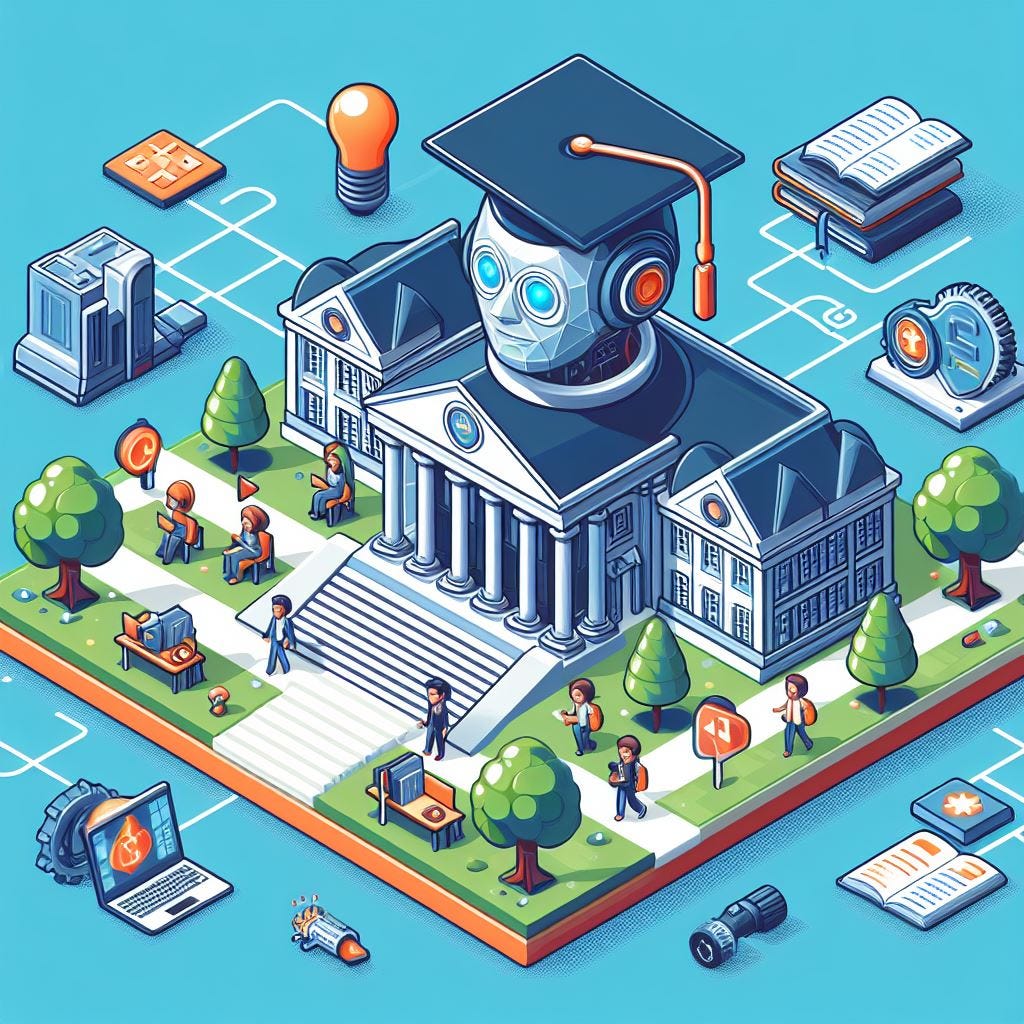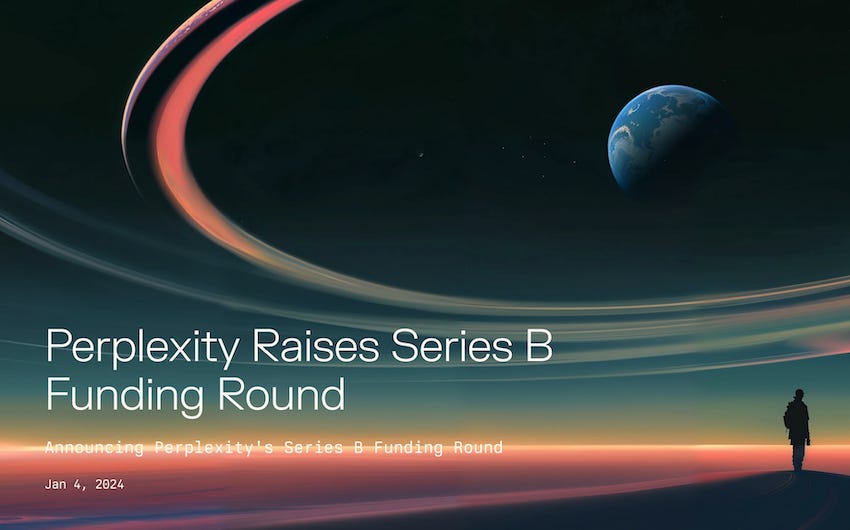ChatGPT Goes to College -- ASU Embraces Generative AI But Won't Pay $100M
OpenAI has many competitive incentives to make this work and expand in education
Arizona State University (ASU) announced a new agreement with OpenAI to provide ChatGPT enterprise to its students, faculty, and administrative staff in February 2024. While the headlines suggest everyone will have access, the announcement is vague as the University is accepting proposals for use. According to the announcement:
Today, the university announced it has become the first higher education institution to collaborate with OpenAI, the AI research and deployment company behind ChatGPT.
…
“ASU recognizes that augmented and artificial intelligence systems are here to stay, and we are optimistic about their ability to become incredible tools that help students to learn, learn more quickly and understand subjects more thoroughly,” ASU President Michael M. Crow said. “Our collaboration with OpenAI reflects our philosophy and our commitment to participating directly to the responsible evolution of AI learning technologies.”
Starting in February, ASU will invite submissions from faculty and staff to implement the innovative uses of ChatGPT Enterprise. The three key areas of concentration include: enhancing student success, forging new avenues for innovative research and streamlining organizational processes.
Customized Learning
CNBC interviewed ASU’s CIO, Lev Gonick, who said the deal has been in the works for six months. It is clear that the university is consdering how tools like ChatGPT can be used to enhance learning in contrast to many schools that fear a rise in plagiarism and disruption to the learning process.
With the OpenAI partnership, ASU plans to build a personalized AI tutor for students, not only for certain courses, but also for study topics. STEM subjects are a focus and are “the make-or-break subjects for a lot of higher education,” Gonick said. The university will also use the tool in ASU’s largest course, Freshman Composition, to offer students writing help.
ASU also plans to use ChatGPT Enterprise to develop AI avatars as a “creative buddy” for studying certain subjects, like bots that can sing or write poetry about biology, for instance.
Gonick said ASU’s prompt engineering course has become one of the university’s most popular courses, not limited to engineering students. The access to ChatGPT Enterprise means students will no longer be limited by usage caps. He also said that after conversations with OpenAI’s leadership, he feels confident that the tool provides a “private walled-garden environment” that will safeguard student privacy and intellectual property.
This progressive view on technology adoption is not new for ASU. In 2017, ASU was one of the first universities to place Echo Dots with access to Amazon Alexa in dorm rooms. That initiative focused first on access to information about student life and later saw some integration with curricula.
It is unclear whether the Alexa program was ever expanded or is still active, but that is unlikely. The value was unclear and the initiative was an experiment. ChatGPT, by contrast, has already shown many direct applications to learning and academic work along with student adoption independent of a university’s endorsement. It will have staying power regardless of what educational institutions embrace or resist the techology.
Generative AI Economics
The announcement is notable on a number of levels. Being the first is always worth noting because it may indicate that a new trend is about to start. This would be particularly true in education, where generative AI and tools like ChatGPT have faced institutional resistance. In this case, the announcement also carries the element of scale. Arizona State University has a very large enrollment.
ASU has about 145,000 students. That breaks down to about 80,000 attending one of the university campuses and another 65,000 enrolled in the university’s online education programs. The university employs about 20,000 staff. ChatGPT Enterprise is currently priced at about $50 per user per month. If ASU were to pay full price and make the service available to everyone, it would represent an annual cost of $99 million. That would represent 11% of the university’s annual operating budget.
So, blanket availability of ChatGPT Enterprise is unlikely unless OpenAI offers a steep discount or ASU limits access. That is where the application process comes in. Either way, the ASU cost and OpenAI revenue could be very large.
It is unlikely that OpenAI would provide full free access to ASU, given the significant cost of running inference jobs through ChatGPT. Compounding this challenge is that university students are more likely to be heavy daily users of ChatGPT with above-average token input and output use per session. However, OpenAI has many incentives to make the deal economically attractive to ASU and might even accept a small loss in order to capture current and future benefits.
OpenAI Seeding the Future
Higher education represents an attractive opportunity for OpenAI in both the near-term and long term Some of the incentives for OpenAI to provide ASU with a hefty discount include:
OpenAI would like ChatGPT and its other products to be more readily accepted by higher education institutions. As more universities formally adopt ChatGPT, it will become harder for competing institutions to avoid adopting the technology. OpenAI is likely to disproportionately benefit from the adoption due to its position as a market leader.
OpenAI would like to avoid its competitors building market share in this segment. Microsoft and Google already have active university programs that promote the adoption of their office productivity software and other services. Universities that standardize on competing products might effectively lock OpenAI and ChatGPT out of widespread adoption at those schools.
OpenAI would like to create habits and preferences among consumers for ChatGPT. If students have free access to ChatGPT but must pay for the most advanced generative AI assistants from other technology providers, they will likely choose the free option. Over time, familiarity with ChatGPT will likely create a lasting preference for the product when the users move into post-school life. They must consider which generative AI tools to favor.
The large pool of users employing ChatGPT for academic pursuits will provide OpenAI with more information about user needs in a learning environment. This may offer an advantage in identifying this user segment's highest-value features and data needs.
The large pool of known knowledge domain specialists may provide OpenAI with a ready pipeline of experts for training foundation models using reinforcement learning with human feedback (RLHF) and supervised fine-tuning approaches. Accessing a pipeline of domain experts is a key challenge today as foundation model developers seek to drive further improvement large language model (LLM) performance.
ASU will benefit from the perception that it is embracing the technology, particularly when competing institutions are resisting it or still considering their options. Plus, if generative AI is proven to enhance the learning environment and achievement, ASU may experience those benefits before its peer institutions.
The most likely outcome is that ASU will get a ChatGPT enterprise discount that will enable it to provide free access to a large number of students and staff in the near-term while offering a discounted price for everyone else.
In addition, if ASU could offer its students ChatGPT Enterprise for $10 per month, that would be a 50% discount over ChatGPT Plus and include more features. Ultimately, I expect ASU to provide the software to its staff while adding a fee for students that may be compulsory for on-campus and optional for online.
Reactionary Educators
Educational institutions around the world spoke about the rise of generative AI as a crisis in late 2022 and early 2023. ChatGPT’s competence accelerated concerns and made the usefulness of generative AI in traditional academic activities an unavoidable topic to confront.
One of the most-read Synthedia articles in December 2022 focused on an organization representing a group of eight leading Australian Universities and their efforts to curb or prohibit the use of ChatGPT. By February 2023, at least nine public school districts in the U.S. had banned ChatGPT, and two others had restricted access or use. Access was also blocked to primary education institutions in five Australian territories. This is a small subset of what was happening around the world.
The resistance was based on two reactionary impulses. First, change is uncomfortable. The economist Thomas Sowell has said, “There are no solutions, only tradeoffs.” Generative AI and ChatGPT may have benefits but also may introduce negative effects. Individuals confront change by taking a positive, neutral, or negative viewpoint. This is true in education as elsewhere.
In academia, the mere fact that generative AI might undermine existing methods for teaching and measuring student performance is at least unsettling. Accepting the new technology would mean also accepting that methods and measurements will necessarily change and that educators will need to expend energy and resources to adapt. This is true whether the net benefit is expected to be positive or negative.
Second, ChatGPT undermines educational institutions’ control over knowledge and its dissemination. You might say that the internet has already torn down the ivory walls erected by the citadels of education to maintain preeminence in knowledge discovery and teaching. However, knowledge on the internet is widely dispersed, and even if it was available, high-status institutions and teachers are looked to for curating the knowledge that matters and is accurate. ChatGPT has access to more information than any single institution or teacher and has turned out to be an extraordinary curator of knowledge.
ChatGPT and its alternatives do produce hallucinations. These confabulations are untrue statements or data that have the appearance of accuracy. They also sometimes generate outputs that some people consider uncomfortable, inappropriate, or dangerous. However, this is also true of information found on the internet, in Wikipedia, in academic textbooks, and in the musings of university professors. In those cases, the errors are sometimes inadvertent and other times intentional.
We have already confronted the tradeoffs of errors or uncomfortable information on the internet and projected by educators. Generative AI assistants are simply the latest channel for this assessment.
Generative AI and Higher Education
Regardless, the ASU announcement is significant, and you should expect similar announcements in the first half of 2024. Universities are fiercely competing for students, faculty, and recognition. Embracing generative AI now is a way for some institutions to stand out before the technology simply becomes a standard expectation.
OpenAI also has another incentive to expand the adoption of ChatGPT Enterprise. Bloomberg reported that ChatGPT Enterprise was adopted by 260 companies with 150,000 users between August and December of 2023. In some regards, that is a fast adoption cycle, but when your key competitors are Google and Microsoft, it is not quite fast enough because they already have millions of companies as customers for their other products.
OpenAI is in a race for ChatGPT adoption across consumer and business use cases. It will look to secure as many corporate customers as possible before they make decisions to go with the comfort of existing software providers.
Meta to Buy 350k NVIDIA GPUs to Train AI Models Like Llama 3 for AGI
Mark Zuckerberg took to Instagram today to reveal Meta’s plans to accelerate the development of (artificial) general intelligence (AGI). While he used the term “general intelligence” and not artificial general intelligence, he seems focused on what would traditionally be called AGI.
Perplexity Hits 10 Million MAUs and Closes $73.6M in Funding for its Answer Engine
Perplexity AI launched its generative AI-powered “answer engine” one year ago, and today, it said it has 10 million monthly active users (MAU). It also closed a $73.6 million funding round led by IVP. Also included in the round are new investors NVIDIA, Amazon founder Jeff Bezos “through Bezos expeditions,” Shopify co-founder Tobi Lutke, and several oth…







